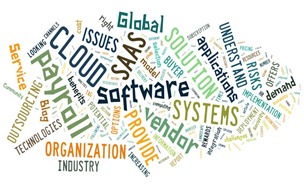 If you’re considering a move to the Cloud for your payroll technologies, you’re not alone. In a recent survey by Constellation Research, Inc. partner Computer Economics, 40% of companies considering payroll technology investments reported such investments involved a move to the Cloud.
If you’re considering a move to the Cloud for your payroll technologies, you’re not alone. In a recent survey by Constellation Research, Inc. partner Computer Economics, 40% of companies considering payroll technology investments reported such investments involved a move to the Cloud.
Why the mass migration? In a recent webinar on the topic, I outlined six key benefits of Cloud-based Payroll. In short, organizations moving their payroll to the cloud are doing so to reap the many benefits of SaaS while ensuring the core objectives of Payroll are met:
- Quality. Innovations arrive faster and are adopted more rapidly in the Cloud than with traditional on-premises and hosted software. With true, multi-tenant SaaS, clients are always on the latest release of the software, enabling organizations to move from periodic jumps to continuous innovation in user experience, workflows and capabilities. If you think this doesn’t matter to user experience, think again. Organizations routinely report higher levels of satisfaction with the usability of SaaS solutions over traditional offerings across all user roles (end users, managers and administrators).
- Cost optimization. An immediate value to organizations – and a large factor behind the movement of technology buying from IT into the line of business – is how easily and quickly SaaS solutions can be deployed to solve immediate business needs. SaaS solutions are implemented on average 82% faster than on-premises solutions and require only 22% of the resources in ongoing staff compared to on-premises shops, freeing up members of the payroll team to focus on more strategic initiatives. (Source: CedarCrestone 2012-13 HR Systems Survey, 15th ed.)
- Risk Mitigation. While many still cite security concerns as a top reason for keeping payroll technology in-house, the reality is that SaaS providers typically excel in security measures (including access controls, backup and recovery, and myriad other potential vulnerability points) due to the large volume of disparate clients continuously pushing their own systems audits and inquiries. SaaS Payroll providers also take on responsibility for ensuring all legal/regulatory changes are applied, tested and available. With tens, hundreds or thousands of customers utilizing these services, it ensures many more eyeballs watching for and reporting any occasional “misses” from the provider and an accompanying rapid response to such issues.
- Control. Managing payroll on premises does not guarantee that the payroll organization has the controls it desires over its technologies and processes. (If you’ve ever waited for your IT organization to apply an update or manage an enterprise upgrade, you know this all too well.) Outsourcing payroll further reduces an organization’s span of control, especially with regard to timing of process flows and reporting/analytics. With SaaS, the payroll organization gets full control over process timing (data entry, audits, check runs, quality checks, adjustments, etc.); anytime access to data, analytics and reporting; and the assurance that the software is always at the latest release with the most recent changes in legs/regs applied and tested.
- Flexibility. SaaS solutions, by design, support the dynamic nature of a business – the ability to rapidly scale hardware needs to support dramatic increases or decreases in resources are inherent to these solutions. But flexibility in the payroll world also means the ability to quickly integrate to local payroll solutions across the globe, to respond to ever-changing time and pay regulations, and to meet the dynamic needs and priorities of the company. SaaS-based payroll solutions leverage the emerging best-practices in cloud-based integrations, ensure the fastest time to readiness in response to changing regulations, and provide the foundation for business agility in global operations.
- Insight. Multi-country payroll almost demands a SaaS solution, as it invariably requires integrations to local payroll providers in countries where a smaller number of employees reside or where major payroll providers have not yet standardized an offering. Those myriad integrations frequently lead to delayed visibility into the actual payroll costs across the globe, causing surprise ‘hits’ to financials. Just over 50% of global organizations today report having a global system of record, and hence are hampered by not having all the global data transparency necessary for timely, strategic decision making. SaaS Payroll providers can rapidly integrate and manage a global view of the payroll activities of an organization, both minimizing financial risks while making available a broader base of data from which to glean additional insights.
Furthermore, when part of a broader global SaaS HRMS platform, SaaS Payroll moves from an administrative to a strategic play as it provides the ability for organizations of any size to dynamically scale operations and to securely plug into global capabilities, and thus engage and compete on a global scale.
Many other facets of SaaS Payroll are explored in this webinar, including a view into social enablement of payroll processes as well as how SaaS can future proof the career of today’s payroll leadership.
The question of SaaS for Payroll, or for any other HCM related initiative, has clearly moved from “Why” to “Why Not?”
Catch the webinar replay here: The Changing Landscape of Payroll: Moving to the Cloud
Disclosure: this webinar was sponsored by Workday, a client of Constellation Research, Inc.Related articles
- Workday Rising: the analysts’ take (zdnet.com)
- CloudPay Raises $16M From Pinnacle, Rho, Others (pehub.com)
- ZenPayroll Launches Cloud-Based Payroll Service With $6.1M In Seed Funding From CEOs At Yammer, Box, Yelp And Dropbox (techcrunch.com)
Filed under: Cloud, Future of Work, Global HCM, Workday Tagged: Apps Strategy, best practices, Business, Business and Economy, Cloud, Cloud computing, constellation research, future of work, HCM, HR, HR Tech, Next Generation apps, Payroll, Social Enterprise, Software as a service, Trends, Workday, yvette cameron ![]()


